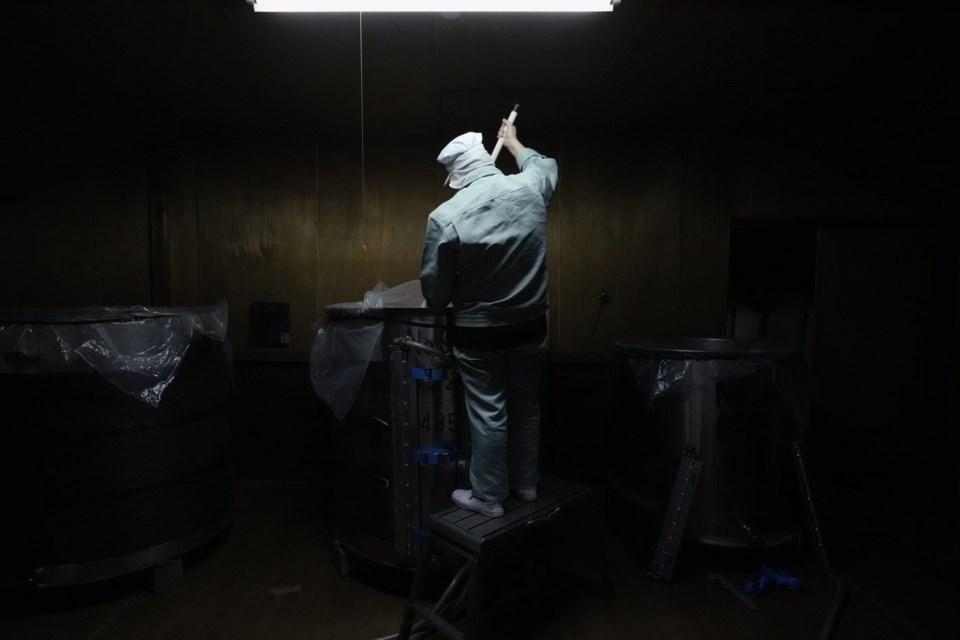OKAYA, Japan (AP) ŌĆö Not long after dawn, Japanese sake brewer Mie Takahashi checks the temperature of the mixture fermenting at her familyŌĆÖs 150-year-old sake brewery, Koten, nestled in the foothills of the Japanese Alps.
She stands on an uneven narrow wooden platform over a massive tank containing more than 3,000 liters (800 gallons) of a bubbling soup of steamed rice, water and a rice mold known as koji, and gives it a good mix with a long paddle.
ŌĆ£The morning hours are crucial in sake making,ŌĆØ said Takahashi, 43. Her brewery is in Nagano prefecture, a region known for its sake making.
Takahashi is one of a small group of female toji, or master sake brewers. Only 33 female toji are registered in JapanŌĆÖs Toji Guild Association out of more than a thousand breweries nationwide.
ThatŌĆÖs more than several decades ago. Women were largely excluded from sake production until after World War II.
Sake making has a history of more than a thousand years, with strong roots in Japan's traditional Shinto religion.
But when the liquor began to be mass produced during the Edo period, from 1603 until 1868, an unspoken rule barred women from breweries.
The reasons behind the ban remain obscure. One theory is that women were considered impure because of menstruation and were therefore excluded from sacred spaces, said Yasuyuki Kishi, vice director of the Sakeology Center at Niigata University.
ŌĆ£Another theory is that as sake became mass produced, a lot of heavy labor and dangerous tasks were involved," he said. "So the job was seen as inappropriate for women.ŌĆØ
But the gradual breakdown of gender barriers, coupled with a shrinking workforce caused by Japan's fast-aging population, has created space for more women to work in sake production.
ŌĆ£ItŌĆÖs still mostly a male-dominated industry. But I think now people focus on whether someone has the passion to do it, regardless of gender,ŌĆØ Takahashi said.
She believes mechanization in the brewery is also helping to narrow the gender gap. At Koten, a crane lifts hundreds of kilograms (pounds) of steamed rice in batches and places it onto a cooling conveyor, after which the rice is sucked through a hose and transported to a separate room dedicated to cultivating koji.
ŌĆ£In the past, all of this would have been done by hand,ŌĆØ Takahashi said. ŌĆ£With the help of machines, more tasks are accessible for women.ŌĆØ
Sake, or nihonshu, is made by fermenting steamed rice with koji mold, which converts starch into sugar. The ancient brewing technique was recognized under UNESCOŌĆÖs Intangible Cultural Heritage earlier this month.
As a child, Takahashi was not allowed to enter her family-owned brewery. But when she turned 15, she was given a tour of the brewery for the first time and was captivated by the fermentation process.
ŌĆ£I saw it bubbling up. It was fascinating to learn that those bubbles were the work of microorganisms that you canŌĆÖt even see,ŌĆØ said Takahashi, who couldn't drink alcohol at the time because she was underage. ŌĆ£It smelled really good. I thought it was amazing that this wonderful fragrant sake could be made from just rice and water. So I thought IŌĆÖd like to try making it myself.ŌĆØ
She pursued a degree in fermentation science at the Tokyo University of Agriculture. After graduation, she decided to return home to become a master brewer. She trained for 10 years under the guidance of her predecessor, and at the age of 34 became a toji at her family brewery.
As the brewery enters the winter peak season, Takahashi oversees a team of seasonal workers and production ramps up. ItŌĆÖs labor-intensive work, hauling and turning large amounts of heavy steamed rice, and mixing thousands of liters (hundreds of gallons) of brew. The master brewer must have the knowledge and skill to carefully control optimal koji mold growth, which needs round-the-clock monitoring.
Despite the intensity, Takahashi manages to encourage camaraderie in the brewery, catching up with the team as they hand-mix koji rice side by side in a hot humid room.
ŌĆ£I was taught that the most important thing is to get along with your team,ŌĆØ Takahashi said. ŌĆ£A common saying is that if the atmosphere in the brewery is tense, the sake will turn out harsh, but if things are going well in the brewery, the sake will turn out smooth.ŌĆØ
The inclusion of women plays an important role in the survival of the Japanese sake industry, which has seen a steady decline since its peak in the 1970s.
Domestic alcoholic consumption has dropped, while many smaller breweries struggle to find new master brewers. According to the Japan Sake and Shochu Makers Association, todayŌĆÖs total production volume is about a quarter of what it was 50 years ago.
To remain competitive, Koten is among many Japanese breweries trying to find a wider market both domestically and abroad.
ŌĆ£Our main product has always been dry sake, which local people continue to drink regularly," said Takahashi's older brother, Isao Takahashi, who is in charge of the business side of the family operation. "WeŌĆÖre now exploring making higher value sake as well.ŌĆØ
He supports his sister's experiments ŌĆō- every year she creates a limited-edition series, Mie Special, that's meant to branch out from their signature dry product.
ŌĆ£My sister would say she wants to try to make low alcohol content, or she wants to try new yeasts -ŌĆō all kinds of new techniques are coming in through her,ŌĆØ he said. ŌĆ£I want my sister to make the sake she wants, and I want to do my best to sell it.ŌĆØ
Ayaka Mcgill, The Associated Press




